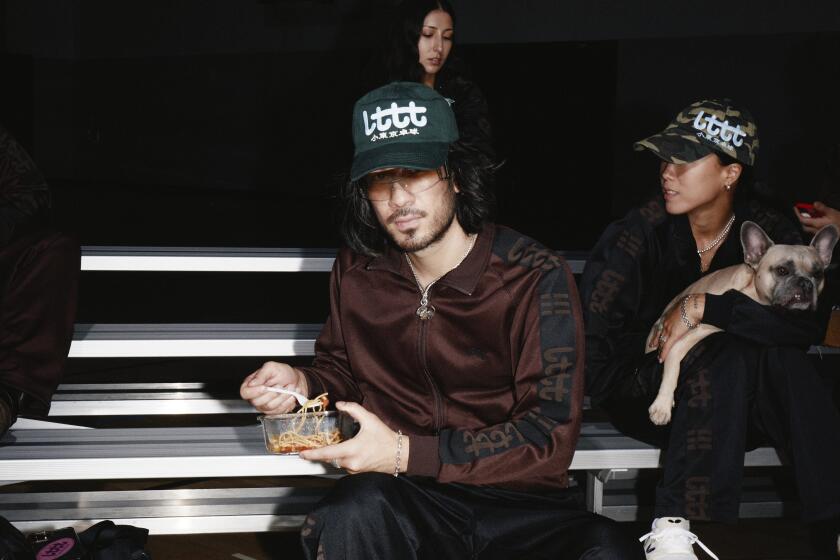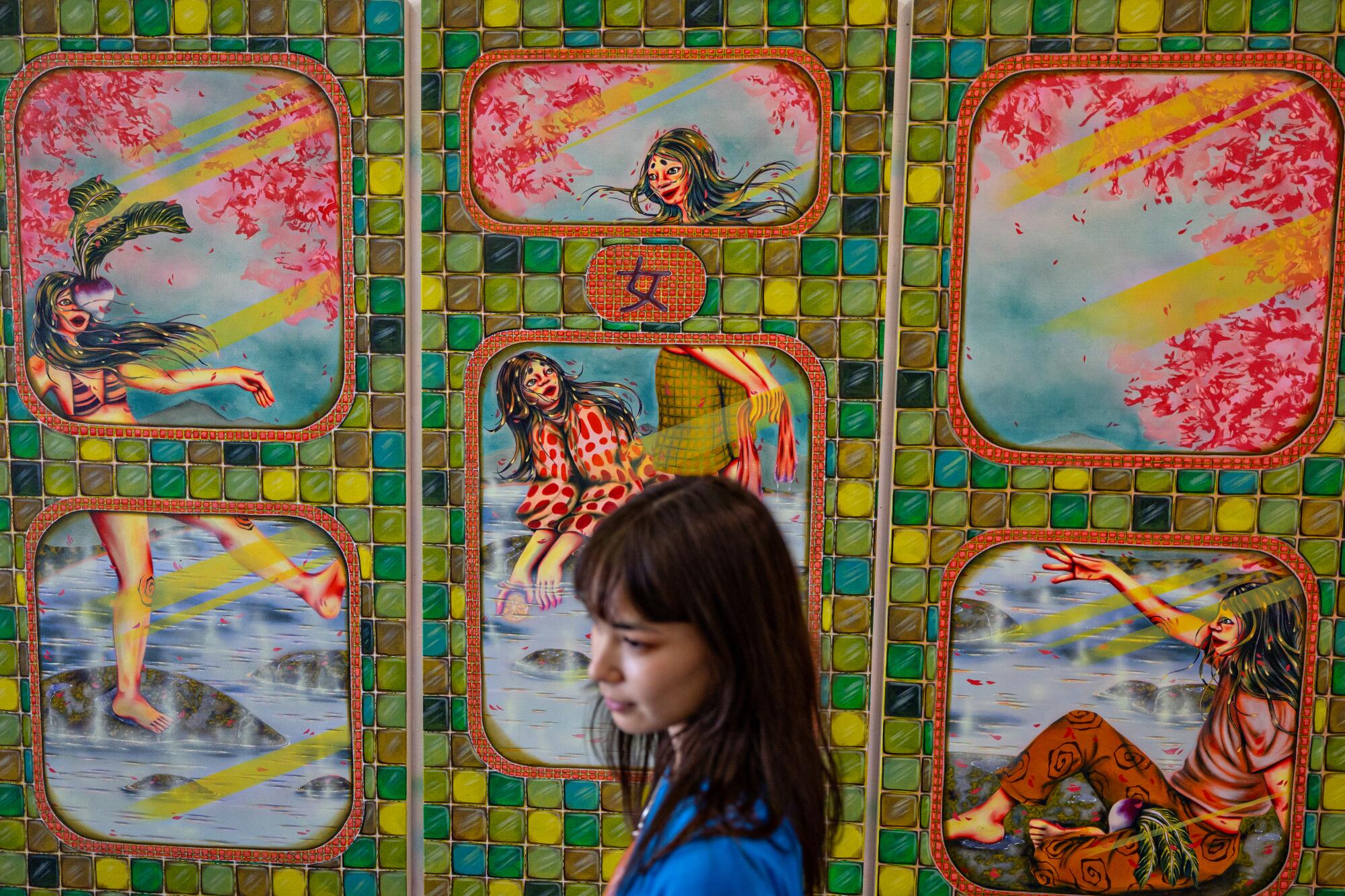
- Share via
This story is part of Image’s May issue, which journeys through environments that encourage, nurture or require stillness.
A woman listens to her CD player as she soaks in the bathtub. Another checks the temperature of her bathwater as she eats a juicy piece of stone fruit. Two lovers embrace at the edge of a hot tub. Women wash their feet, women soak their feet. A woman lotions her legs in the locker room, cream dripping down her shins like smoke and pooling in a puddle beneath her.
There are images of bathing throughout painter Zoé Blue M.’s early oeuvre, but in her latest exhibition, “Hard Boiled,” M.’s first solo show at Jeffrey Deitch in New York, the Japanese bathhouse is at the center. More specifically, “Hard Boiled” features scenes from the takkyu onsen — a Japanese phrase that translates to “table tennis bathhouse.”
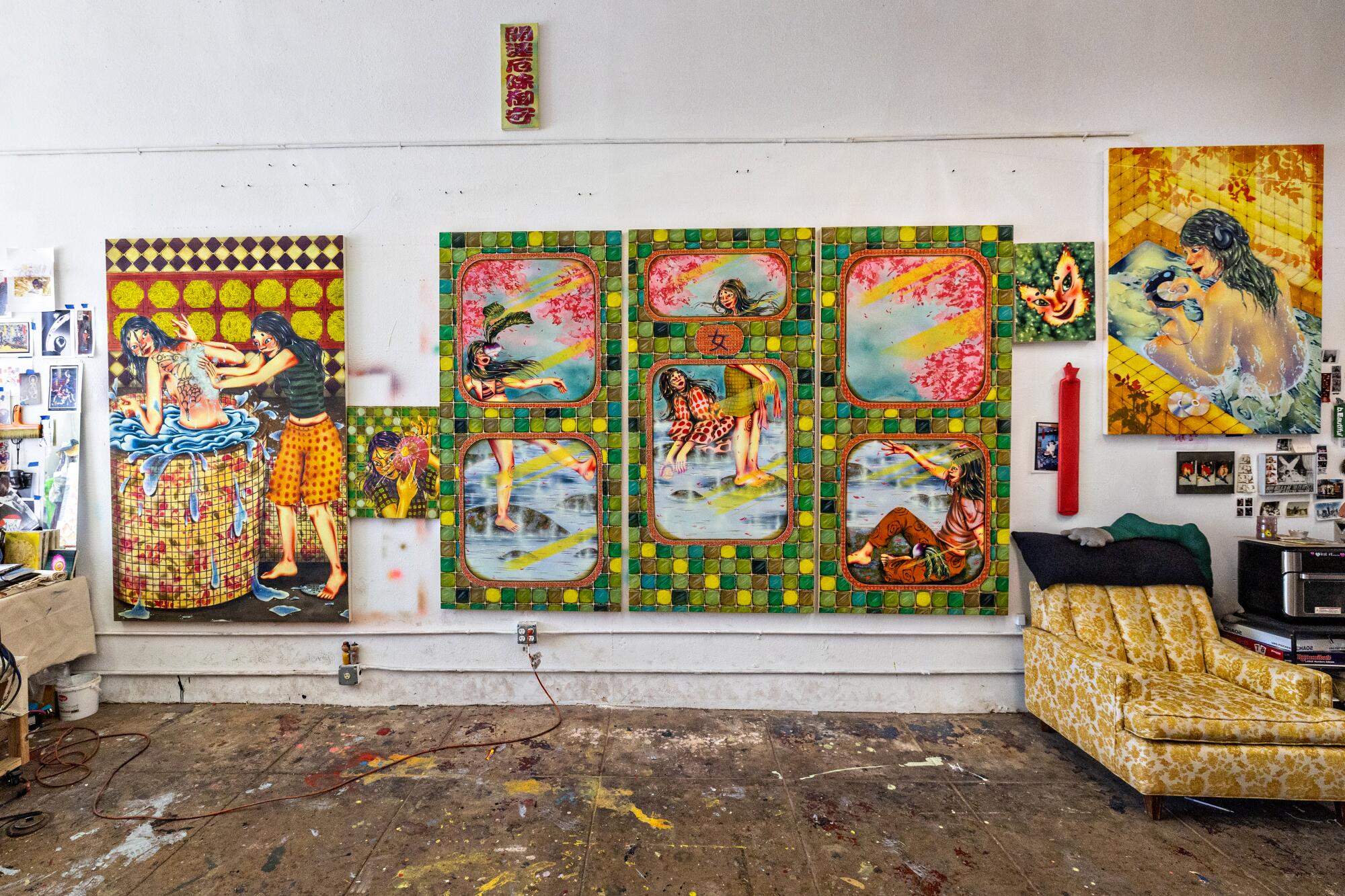
For M., the takkyu onsen is a space that is both real and imaginary. While many modern bathhouses feature areas for table tennis, the way M. merges the sport with the spa in her paintings is more personal. She is a fixture at Little Tokyo Table Tennis — the pingpong club, clothing brand and cultural community founded by her brother, Jiro Maestu — and a fan of Grand Spa and Beverly Hot Springs. Whether she’s slipping into a hot tub or slapping a pingpong ball with her paddle, the artist cherishes both environments for helping her to hyper-focus into her own breath and body. Her paintings come from these pauses.
In this as-told-to interview, the L.A. native discusses creating “Hard Boiled”and the way caring for her body has become a part of her practice as a painter.
I’m fascinated with bathing as a ritual. It’s almost like you live your life with a lens on and then it’s removed in the bathhouse. You focus on the beauty of the body, the beauty of femininity. Everything feels more beautiful in the bathhouse. Every style of body feels so beautiful. I’m most interested in existence within these spaces, and seeing in these spaces. Allowing the body, aging bodies, different types of bodies, to become part of one’s visual landscape. There’s no better education than just seeing, at least to start.
I was also thinking about bathhouses as these places used to fetishize women in Japanese pop culture and manga. [I was looking at] the beauty of this space, while keeping in mind how people have used images of it in a fetishistic way. But if we can’t look at things in more than one way, how are we ever going to reframe anything?
In this painting [“Butterfly”], she has a big back tattoo, which wouldn’t traditionally be allowed in a bathhouse. I made it a butterfly because the show is about these bathhouses that have pingpong, and Butterfly is a really famous table tennis brand. This painting is actually a repurposed image from a traditional Japanese bathhouse. It’s an amalgamation of a lot of different things, but it’s based on an image of an actual bathroom I saw. Architecturally, it’s very similar to the bathroom in the photo, I just changed all of the tiling and other things about it. I freaked it.
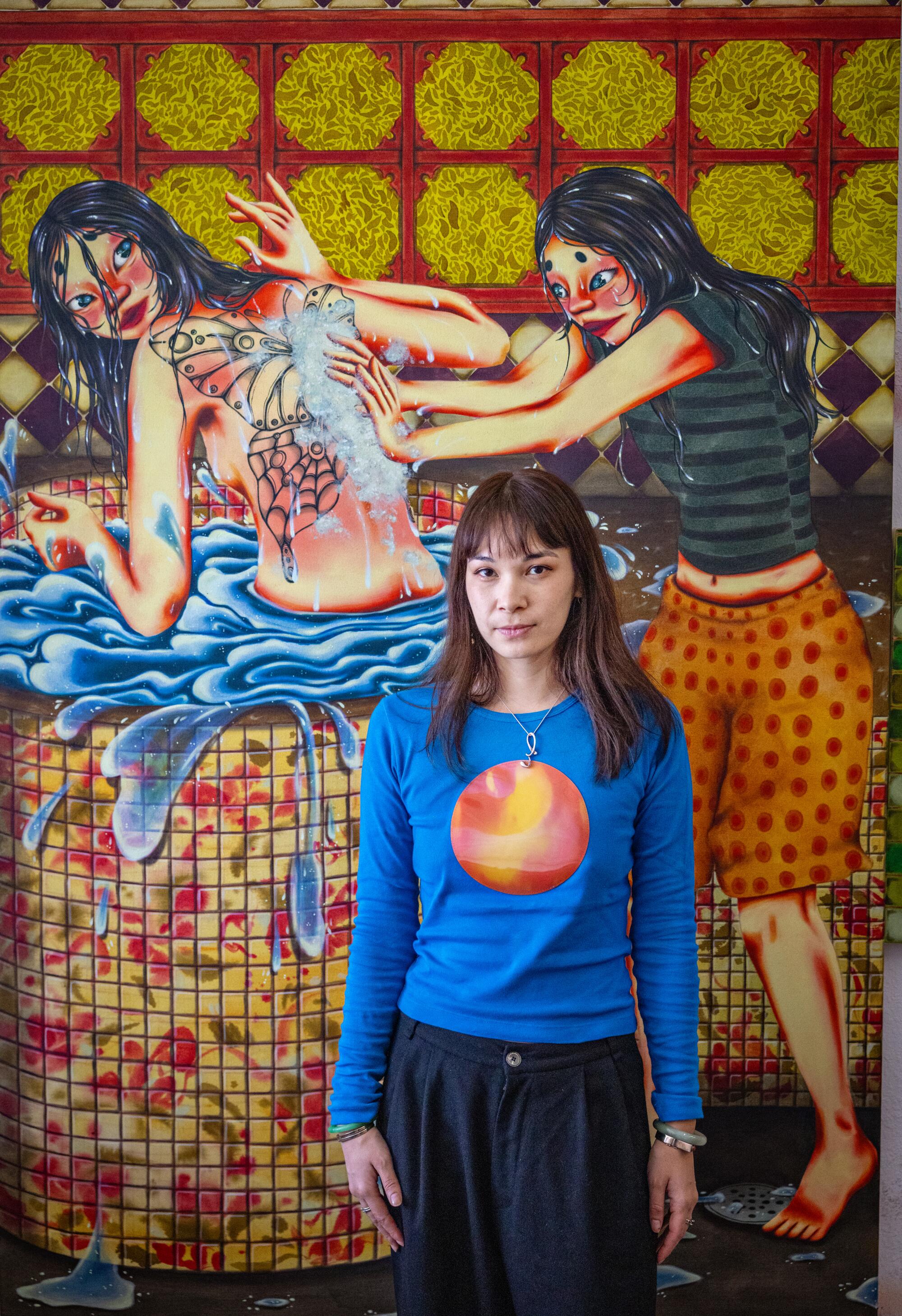
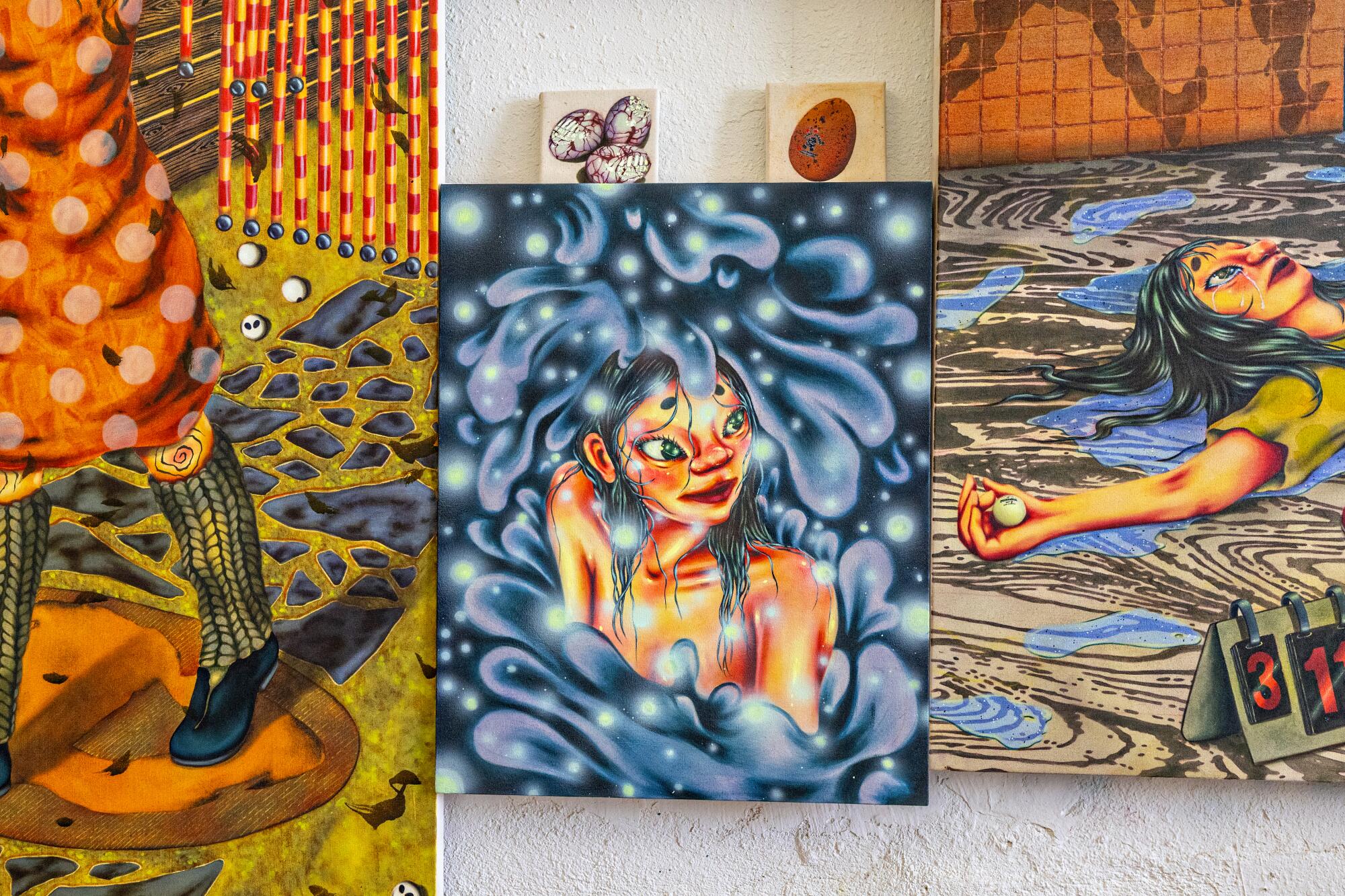
I started doing the same face for everything because in Japanese ukiyo-e prints, the figuration is always the same — like every girl in a print will have the exact same face but have different outfits. In terms of anime, it’s often the same template of a face, and then everything else changes around it. I was also into religious narratives, like frescoes, where it’s the same person doing something over the course of time in one frame. So it’s all of those ideas in one style of figuration.
I’m very focused on breaking down the hierarchy of what figurative painting is. In theory, a portrait would be a figurative painting in the sense that the painting is about that figure. But I’m more interested in painting that utilizes figuration, where there’s no longer that hierarchy. Everything has value to it at an equal level. Or sometimes, the architecture has more value than the figure. In a lot of Impressionist paintings, nature is actually the main character and the figures kind of get absorbed into it. I’m trying to utilize that in my paintings. I don’t want them to be as much about the figure as the color, the temperature in the space, the wind or the water. All of these things are just as important. Within a bathhouse, there are so many different rooms, with their own temperatures, made out of different things.
Chances are you have crossed paths with LTTT somewhere. The fashion brand by Jiro Maetsu is an “unspoken but blatant community” that has exploded from L.A. to the world.
Obviously, these paintings move a lot, but they’re also oddly still. A while ago, I discovered this thing in Kabuki theater called mie. It’s when, within the play, the actor strikes this really dramatic pose. It’s a tool the actor uses to draw the attention of the viewer to an important moment. It’s a very dramatic pose with a very dramatic facial expression, but done with complete stillness. When I discovered this concept, I knew that’s what I wanted my paintings to be like. I wanted my figures to be midjump, but still. Within that moment of stopping, there’s all of this information. That’s what stopping does a lot of the time. The minute you stop and think [is] the minute you can parse things out. My paintings come from this moment of stopping, where within stopping there is movement.
It’s interesting to think about hyper-focusing into an action for a moment. In pingpong, all you’re thinking about is the ball. How do I hit it this time? Getting in the cold plunge is all about paying attention to your breath in the cold. A lot of my work is hyper-focusing into one moment. But then, in these paintings, there’s a lot of these little moments happening at the same time.
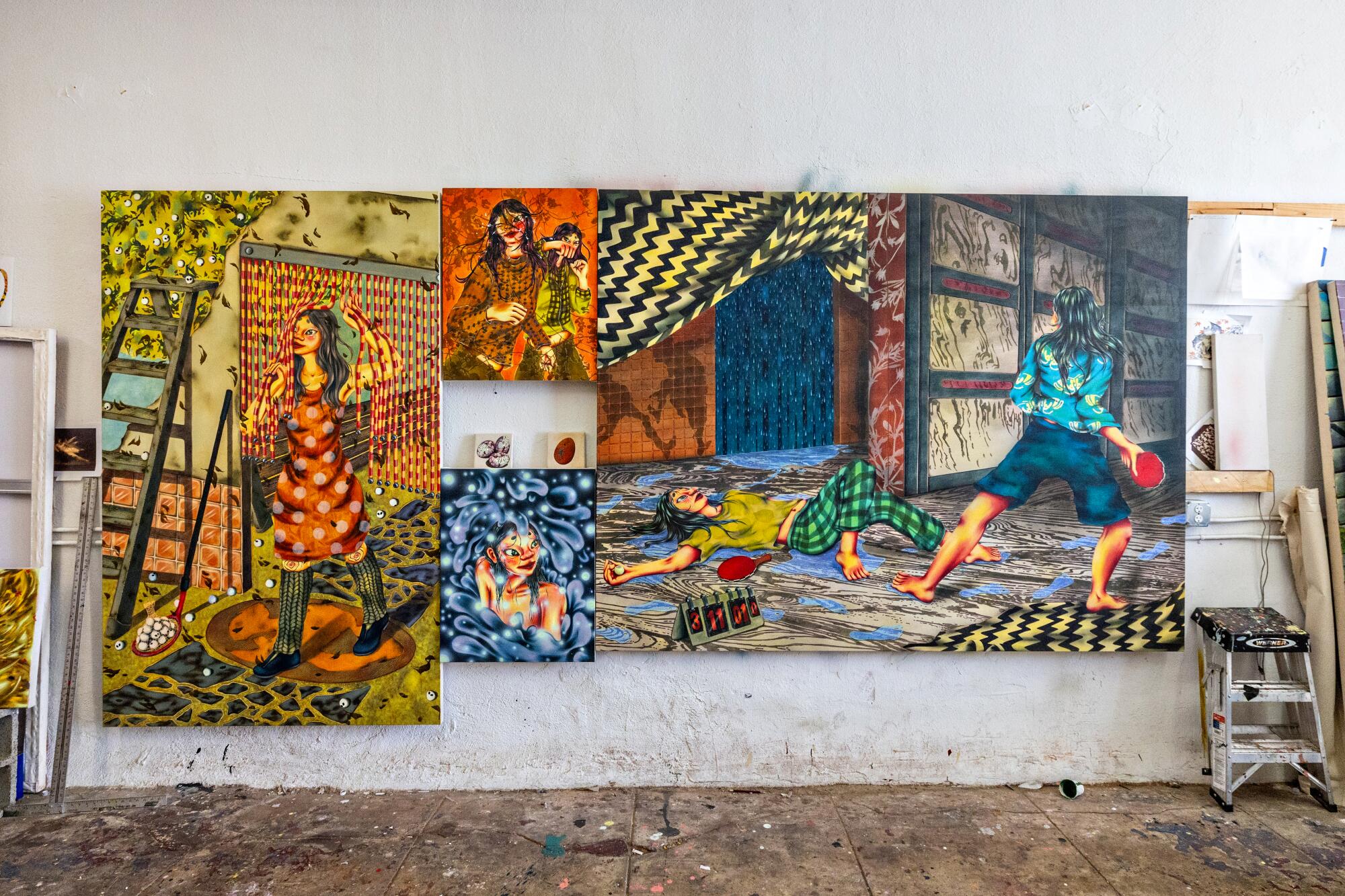
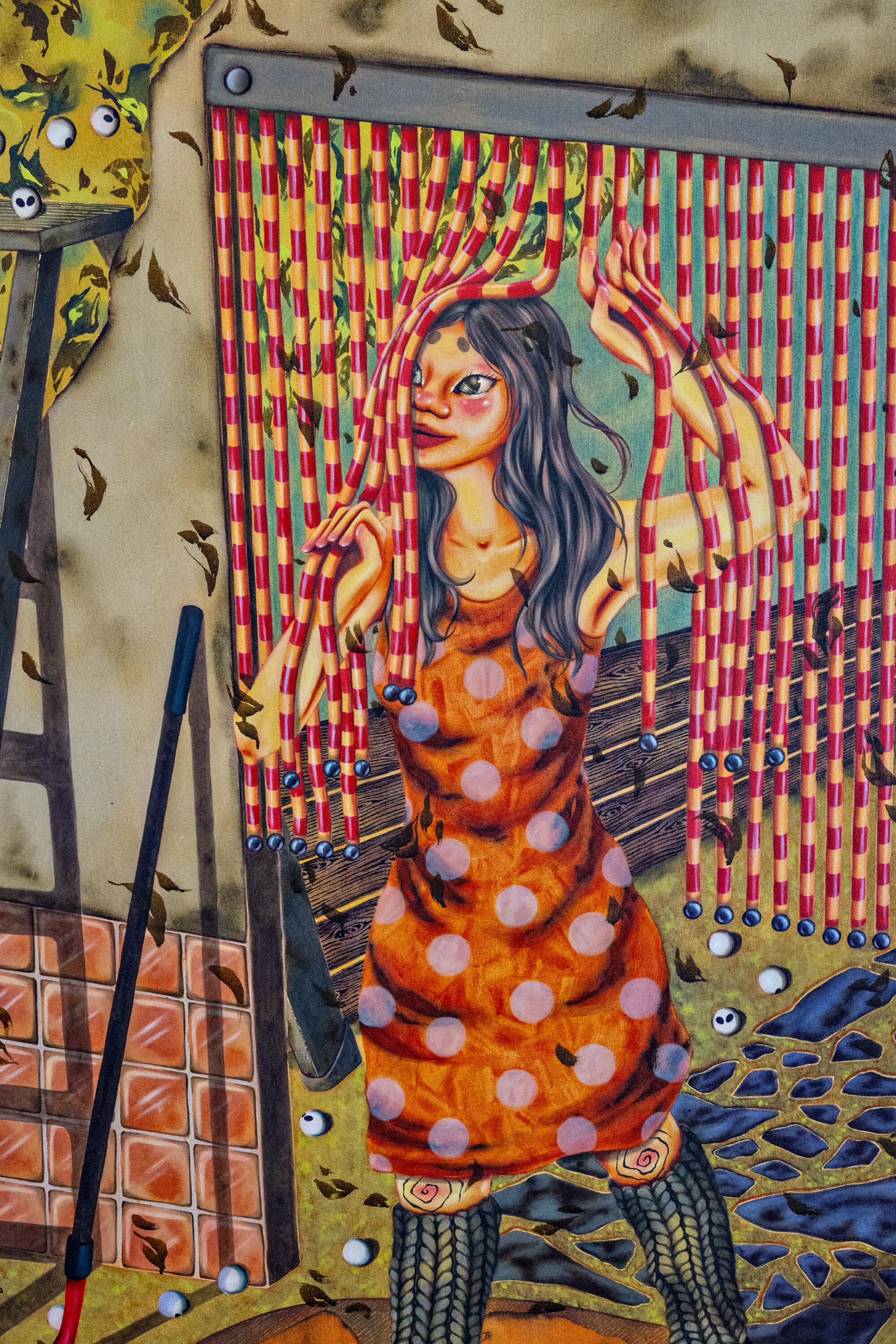
I went through years of being the most deeply unhealthy person, in relation to my practice and my life. About a year ago, my body was pretty much deteriorating. My hands weren’t good. My back was killing me. I wasn’t exercising. Everything was in the way of my time in the studio. Once I met [my boyfriend] Allek, whose whole thing is health and preservation, I learned a lot about longevity and sustainability. How do I keep painting? In the duration of making this body of work, I nailed down how to reframe my whole lifestyle to make this sustainable for me. How can I do this for the rest of my life?
For a long time, I thought it was so much cooler and punk to always be in the studio. Rip Adderall. Never sleep. Have 45 Red Bulls a day. Paint my head off. Also, being bipolar, I was really into mania. I was down with the highs and lows; I thought that was the price. I was used to it, I liked it, and I thought I needed it.
There’s also something about growing up in a place that feels like being on the precipice of the end of the world more than other places. I have a romantic relationship to that. I always felt scared growing up. It’s part of the paintings. Everything is on the precipice of disaster, and it might never come, but we’re always aware of it. It’s how mental illness feels. There’s an energetic field to that. In that way, I just have this relationship with L.A. that I love.
I find my work deeply ingrained in L.A. My mom is deeply L.A. We’re deeply Japanese American, from L.A., from Little Tokyo. We have a lot of roots here. That’s so much a part of my work. I don’t need to preach L.A. to anyone, but I’m definitely a diehard L.A. girly. I couldn’t imagine being anywhere else.

Tierney Finster is a writer, editor and artist whose work has appeared in Dazed and Confused, the Face, MEL, Playboy, Pin-up and others. She was born in the Valley and loves L.A.

